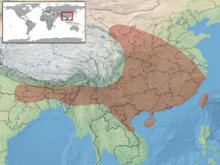Trimeresurus mucrosquamatus
| Trimeresurus mucrosquamatus | |
|---|---|
 | |
| Scientific classification | |
| Kingdom: | Animalia |
| Phylum: | Chordata |
| Subphylum: | Vertebrata |
| Class: | Reptilia |
| Order: | Squamata |
| Suborder: | Serpentes |
| Family: | Viperidae |
| Subfamily: | Crotalinae |
| Genus: | Trimeresurus |
| Species: | T. mucrosquamatus |
| Binomial name | |
| Trimeresurus mucrosquamatus (Cantor, 1839) | |
 | |
| Synonyms | |
| |
Trimeresurus mucrosquamatus is a venomous pit viper species endemic to Asia. No subspecies are currently recognized.[6]
Description
Males grow to a maximum total length of 112 cm (44 in) with a tail length of 19.5 cm (7.7 in). Females grow to a maximum total length of 116 cm (46 in) with a tail length of 20.5 cm (8.1 in).[7]
Scalation: dorsal scales in 25 longitudinal rows at midbody; scales on upper surface of head, small, each scale keeled posteriorly; internasals 5-10 times size of adjacent scales, separated by 3-4 scales; supraoculars, long, narrow, undivided, 14-16 small interoculars in line between them; 2 scales on line between upper preocular and nasal scale; 9-11 upper labials, first upper labial separated from nasal by suture; 2-3 small scales between upper labials and subocular; 2-3 rows of temporal scales above upper labials smooth, above those scales keeled; ventrals 200-218; subcaudals 76-91, all paired.[7]
Color pattern: grayish or olive brown above, with dorsal series of large brown, black-edged spots or blotches, and a lateral series of smaller spots; head above brownish, below whitish; belly whitish but heavily powdered with light brown; tail brownish (possibly pink in life [fide M.A. Smith 1943:507]), with series of dark dorsal spots.[7]
Common names
Brown spotted pitviper,[4] pointed-scaled pit viper, habu,[5] Taiwan habu (タイワンハブ), Chinese habu, Formosan pit viper.[8]
Geographic range
Found from northeastern India (Assam) and Bangladesh, to Myanmar, China (Fujian, Jiangxi, Guangdong and Sichuan), as well as in Taiwan. The type locality given is "Naga Hills" (India).[2] This snake is introduced to Okinawa, Japan.
See also
- List of crotaline species and subspecies
- Trimeresurus by common name
- Trimeresurus by taxonomic synonyms
- Crotalinae by common name
- Crotalinae by taxonomic synonyms
- Snakebite
References
- ↑ Papenfuss, T.J. (2010). "Protobothrops mucrosquamatus". IUCN Red List of Threatened Species. Version 2012.1. International Union for Conservation of Nature. Retrieved 20 October 2012.
- 1 2 McDiarmid RW, Campbell JA, Touré T. 1999. Snake Species of the World: A Taxonomic and Geographic Reference, Volume 1. Herpetologists' League. 511 pp. ISBN 1-893777-00-6 (series). ISBN 1-893777-01-4 (volume).
- ↑ The Reptile Database. www.reptile-database.org.
- 1 2 Gumprecht A, Tillack F, Orlov NL, Captain A, Ryabov S. 2004. Asian Pitvipers. Geitje Books. Berlin. 1st Edition. 368 pp. ISBN 3-937975-00-4.
- 1 2 U.S. Navy. 1991. Poisonous Snakes of the World. US Govt. New York: Dover Publications Inc. 203 pp. ISBN 0-486-26629-X.
- ↑ "Trimeresurus mucrosquamatus". Integrated Taxonomic Information System. Retrieved 25 May., 2007. Check date values in:
|access-date=(help) - 1 2 3 4 Leviton AE, Wogan GOU, Koo MS, Zug GR, Lucas RS, Vindum JV. 2003. The Dangerously Venomous Snakes of Myanmar, Illustrated Checklist with Keys. Proc. Cal. Acad. Sci. 54 (24): 407-462.
- ↑ Brown JH. 1973. Toxicology and Pharmacology of Venoms from Poisonous Snakes. Springfield, Illinois: Charles C. Thomas. 184 pp. LCCCN 73-229. ISBN 0-398-02808-7.
Further reading
- Boulenger, G.A. 1890. The Fauna of British India, Including Ceylon and Burma. Reptilia and Batrachia. Secretary of State for India in Council. (Taylor and Francis, Printers.) London. xviii + 541 pp. (Trimeresurus mucrosquamatus, p. 428.)
- Cantor, T.E. 1839. Spicilegium Serpentium Indicorum [parts 1 and 2]. Proc. Zool. Soc. London, Part VII 1839: 31-34, 49-55.
- Kraus, Fred; Mink, Daniel G.; & Brown, Wesley M. 1996. Crotaline intergeneric relationships based on mitochondrial DNA sequence data. Copeia 1996 (4): 763-773.
- Smith, M.A. 1943. The Fauna of British India, Ceylon and Burma, Including the Whole of the Indo-Chinese Sub-region. Reptilia and Amphibia, Vol. III.—Serpentes. Secretary of State for India. (Taylor and Francis, Printers.) London. xii + 583 pp. (Trimeresurus mucrosquamatus, pp. 507–508.)
- Tu, M.-C. et al. 2000 Phylogeny, Taxonomy, and Biogeography of the Oriental Pit Vipers of the Genus Trimeresurus (Reptilia: Viperida Crotalinae): A Molecular Perspective. Zoological Science 17: 1147-1157.
External links
- Protobothrops mucrosquamatus at the Reptarium.cz Reptile Database. Accessed 6 December 2007.
- Protobothrops mucrosquamatus at Uetz Lab. Accessed 6 December 2007.
